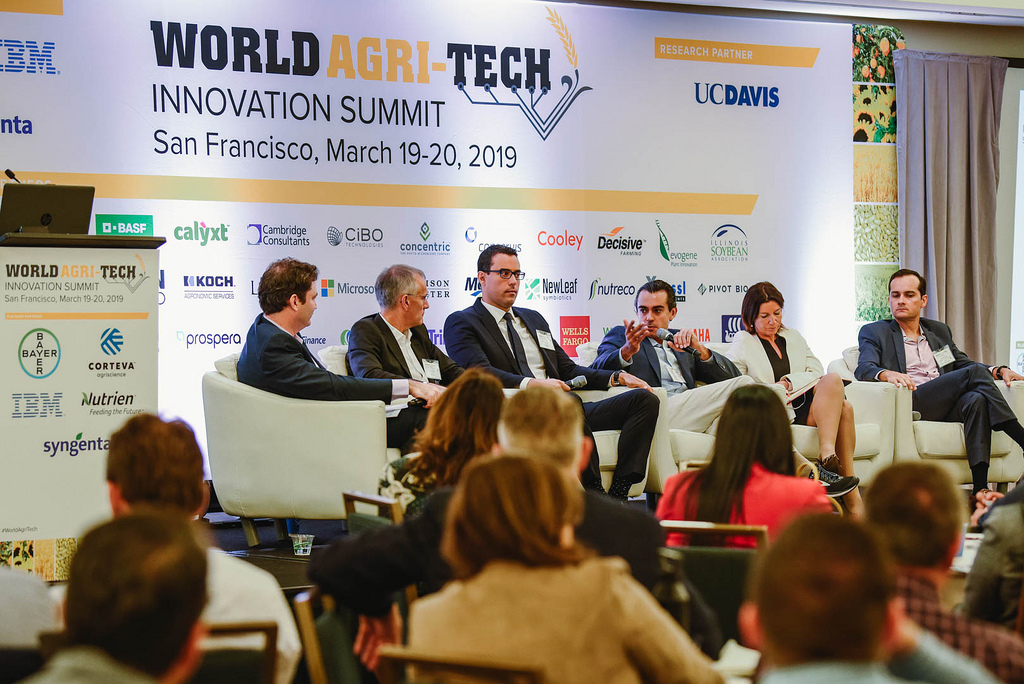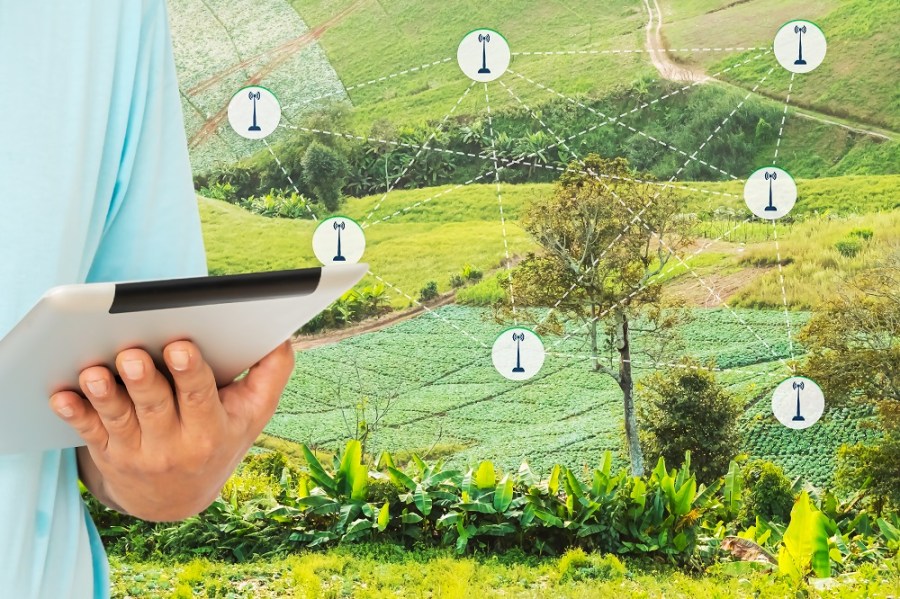Some of the biggest names in computing, web and digital industries gathered at the World Agritech Summit in San Francisco to explore opportunities in agriculture. CPM asked independent consultant Keith Norman for a report.
Be okay to walk away from ideas that don’t work – you haven’t failed, you’ve just found something that didn’t work.
By Keith Norman
The World Agritech Summit in San Francisco was certainly an earth-moving event – the opening remarks were accompanied by a 20sec earthquake, measuring 1.3 on the Richter scale.
There was something quite unusual about this event in that, apart from earthquakes, the line-up of speakers was very different to most agricultural conferences. Amazon, Google, IBM, Microsoft, Airbus, Bosch, Wells Fargo were key presenters with a common goal and determination to be a part of our industry. They all shared a vision that we need to double agricultural output by 2050, in both food and non-food products.

The line-up of speakers was very different to most agricultural conferences.
The range of subjects covered was vast. Remote sensing (drone, fixed wing and satellite), nutrition, biocontrol, soil health, robotics, real-time biosensors, diagnostics, artificial intelligence, machine learning, modelling, plant breeding, genetics, gene editing.
It was reassuring that as the presentations progressed, it was very easy to relate at least one or more UK-based companies or research institutes, that were leaders in many of these technologies – many of the San Francisco presentations were great in concept, but were light in detail. It suggests that the UK is a global front runner in the development of Agritech.
Adapting crop production to climate change was also an underlying theme, with agriculture using two thirds of fresh water on a global basis.
It was a generally recognised view that future crop production won’t be in the hands of a single company, but very much a combination of small, niche companies who have complementary skill sets, and whose collective expertise will have a greater impact than anything that would be delivered on their own.
The replacement of agrochemicals with bioscience was high on everyone’s agenda too. The increasing problems associated with resistance and regulation together with the negative public perception of agrochemicals, was a key driver to change. Novel target identification of critical enzyme pathways in weeds, pests and diseases where biological interventions could be effective was a key area for future research. Manufacturers are starting to use artificial intelligence themselves, to increase the speed and probability of discovering and developing new crop protection products.
Data-driven applications that visualize and analyse crops to aid in better decisions and improve yield were also very much on display. The term “Predictive Crop Production” was used on more than one occasion.
One example was BASF’s Xarvio field management system, which has two components:
Spray Timer delivers recommendations to a grower’s mobile device on the right timing for maize and winter wheat fungicide application by combining field-specific data (geolocation, crop rotation, crop/variety, previous applications) with variety data (susceptibilities, growth stage characteristics) and local weather data (air and soil temperature and humidity).
Zone Spray, now available for oilseed rape, incorporates satellite imagery to identify productivity zones and then creates variable-rate fungicide application maps. It automates the process to identify low productivity zones where a fungicide application isn’t economically beneficial. As a result, growers can more precisely apply fungicides to the highest productivity zones, making fungicide applications cost-effective in more fields and improving their economic return in a sustainable manner. Xarvio is available in more than ten countries and eight different field crops to date.
Realtime, infield biosensors that are able to quantify the DNA of airborne diseases are getting nearer to being a reality too, as well as in-field nutrient sensors that can monitor the levels of key nutrients as the crop grows.
One sound piece of advice from the head of Amazon Web Services Cameron Holbrook was “Be okay to walk away from ideas that don’t work – you haven’t failed, you’ve just found something that didn’t work.” This concept was demonstrated by the Amazon Fire-Phone that was a complete flop and had cost Amazon $170M (£130M), however, the speech recognition technology in the phone is now what powers Alexa, which has generated millions of dollars in revenue.
Linkage of this type of technology is already being considered in the crop production domain. Maybe in future, we could ask Alexa the growth stage or disease levels in a specific field as you eat your breakfast? Microsoft are actively looking at ways of managing your farm directly from a laptop without the need for ever going into a field.
In the queue for outputs from future Agritech were not only farmers, but governments and grain traders to more accurately assess supply and demand of key crops. Banks and insurance companies look for crop validation, insurance, credit risk, lending etc. We’re all familiar with the term Agritech, but Fintech, (computer programs and technology used to support the banking and financial services) was just as prominent throughout the conference.
One quite sobering statistic quoted during the conference was that globally, we spend ten times more money “fixing people” than “feeding people”, and that at some point governments around the world are going to wake up to this. It was also stated that if everyone adopted the Mediterranean diet, it would have a serious negative effect on the global pharmaceutical industry.
There were many presentations and references to growing crops with genetically enhanced traits that matched specific human dietary needs. For example, starch that was tolerable to celiac patients, sugar that was less efficiently absorbed by the gut for diabetics, biofortified wheat with essential trace elements in flour.
Many new technologies were seen as being able to provide plant breeders with the tools to enable high-throughout phenotyping and in-field-testing, with a result of introducing better varieties sooner than the current ten years from an initial cross to a bag of seed on a shelf.
Enhancing the photosynthetic capacity of rice and wheat was very high up on the agenda of the Bill and Melinda Gates Foundation. A lot of money is being invested in transferring the capabilities of a 4C crops such as maize into 3C crops such as wheat and rice. Tweaking rubisco in plants which is a key component of photosynthesis is now considered a real possibility. Wheat has only a 3.5% efficiency of photosynthesis, so there is a lot of room for improvement. There are 12 plant species globally that provide approx. 75% of total food supply. Wheat, rice, maize and potatoes provide more than all the others combined.
Some technological developments are ahead of effective delivery mechanisms. One example of this is a new crop growth/lodging risk product that the UK data analytics company Hummingbird is developing. Crop growth rate is measured at thousands of specific points in a field over a period time. RTK-enabled drones can measure crop height with an accuracy of 3cm. The lodging risk of the variety can then be modelled together with drilling date, resulting in a lodging risk map.
But how can a farmer take advantage of this crop information? Presently it’s not possible to variably apply a late growth season PGR as part of the T2 fungicide/PGR mix. However, it was really good to hear that Bosch were developing a new nozzle in conjunction with BASF that could apply up to six different individual components of a tank-mix, at different rates, on the move. This could be a real game changer.
When it comes to big data, how big is big? If you believe many of the presentations, crop production in the future will all be about monitoring individual plants in a field, and treating them as individuals in terms of their specific nutritional, disease and pest control needs, as well as controlling adjacent weeds. Broad spectrum, prophylactic applications will be a thing of the past. In other words, “manage the plant, not the crop”.
Conceptually, this sounds absolutely the right thing to do, but there are many practical considerations in terms of the delivery of the individual applications, and how to gather the individual plant data.
To get effective and “added value” big data, there’ll be a reliance on data sharing by farmers. There is, understandably reluctance in sharing data, but if trust can be won over, and that the combined data will add much more to a farmer’s knowledge than their data alone, there’ll be traction for this concept.
However, it was interesting to hear the other side of the argument to “. regarding it as a threat to climate change! In reality, cloud-based storage systems are data centres, which are windowless, featureless buildings scattered across the globe, from Las Vegas to Bangalore. Their construction costs alone are around $20bn (£15bn) a year worldwide. The biggest covers a million square feet, and consumes as much power as a city of a million people to power the servers and cool them. Combined, data centres consume more than 2% of the world’s electricity and emit roughly as much CO2 as the airline industry. The prediction is that global data will more than double every four years.
One vital aspect recognised in bringing all these digital technologies together into a realm of predictive crop production, is that there must be an effective way of demonstrating them in the field. The technologies themselves need to be supported with technical translation and clearly defined financial, societal and environmental benefits. It’s good to know that Innovate UK, the Government initiative to develop UK technology, is about to fund demonstration projects as part of its Industrial Sector Challenge Fund. In the private sector, there are new initiatives such as Hutchinson’s Helix Project that has been designed to do exactly this.
However, one science was absent from the platforms, that being social science, and some argue this is one of the most important sciences to get right. We can have the most brilliant agri-technologies in the world, but if the public says no, we’re stuck where we are, it was pointed out. We should learn from the badly managed introduction of GM.




